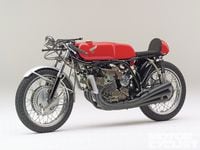Grand Prix racing underwent a revolution in the early 1960s. Everything changed after MZ rider/engineer Ernst Degner defected from East Germany in 1961, taking Walter Kaaden’s two-stroke engine-tuning secrets straight to Suzuki. Once the rest of the world learned how exhaust pressure waves could be manipulated to make huge horsepower, everyone began developing two-stroke racing machines.
Soichiro Honda was the exception. He had earlier made a very public, company-wide commitment to quieter, cleaner-burning, more efficient four-stroke engines. And because Honda’s racing effort existed solely to advance production designs, his race engineers were forced to find innovative ways to further exploit four-stroke technology.
They had their work cut out for them. Every crankshaft rotation in a two-stroke engine is a power stroke, with pressure waves scavenging the exhaust. Four-strokes only produce power with every other crankshaft rotation—one rotation is “wasted” purging spent gas. The only possible way to produce equal power was to double engine speed. But how to do that without sacrificing reliability?
The solution was miniaturization. Smaller cylinders have a smaller bore, permitting a shorter stroke and higher engine speed without risking rod-bearing failure. Four smaller valves provided the same surface area as two, with less valve spring stress. This was Honda’s formula for four-stroke racing success: many tiny cylinders, four-valve heads and stratospheric engine speeds. It was a brilliant, original theory, and Honda secured the 1962 125cc, 250cc and 350cc world championships and the 250cc and 350cc titles again in ’63.
By ’64 rivals were catching up, especially in the 250cc class where Yamaha two-strokes regularly beat the four-cylinder Honda RC161. The engineer put in charge of revitalizing the 250cc platform was 24-year-old Soichiro Irimajiri. Young Iri-san’s solution was simple: more cylinders! The RC165 he created, powered by an inline-six with six carburetors and 24 valves, was an engineering masterpiece. The six was no wider than the four it replaced—just 14 inches across—and the finished bike was narrower than the Yamaha twin it competed against. The cylinder block was cast as a part of the upper crankcase, and each set of three cylinders shared a head for better sealing. Each Keihin 22mm round-slide carb used five tiny fuel and air jets in place of a main jet, and the inner carbs ran richer to assist with engine cooling. Power output was over 60 bhp at a stratospheric 18,000 rpm.
The top-secret RC165 debuted mid-season at Monza, entered as a “3RC164” to suggest it was just an evolution of the four-cylinder machine. Honda even shipped it to Italy with only four exhaust pipes in place, to further conceal its identity. No one paid attention to the new bike until Jim Redman fired it up for the first practice. As soon as everyone heard the ear-splitting six-cylinder shriek, they knew it was something special!
With a top speed over 150 mph, Honda’s six easily outpaced Yamaha’s two-stroke twins, but reliability was a problem. It handled poorly, too. The RC165 won its second race, the Japanese GP at Honda’s own Suzuka circuit, but by then Yamaha had already locked up the championship. Real success wouldn’t come until 1966, when Mike Hailwood returned to Honda (after a four-year stint at MV) and tamed the six’s unruly handling. After his first ride on the RC165, Hailwood asked mechanics to remove the Honda-made rear shocks so he could inspect them. Once in his hands, he reportedly threw the shocks into a nearby pond and demanded they be replaced with Girlings! Hailwood also ordered the frame totally redesigned with stiffer tubing and the wheelbase lengthened 3.5 inches. Additional cooling came via an oil-cooler, extra finning and head cutouts.
Refining the second-generation RC166 proved worthwhile. Hailwood blazed to victory at the first GP of the year in Barcelona and maintained his pace throughout the season, winning the 1966 world championship with 10 victories in 10 starts. He repeated again in ’67, his domination nearly as complete. Hailwood might have gone three-for-three in ’68 had Honda not announced in February of that year that it would withdraw from GP racing completely, to concentrate resources on Formula 1 auto racing.
The ’60s are now considered the glory days of Grand Prix motorcycle racing, pro-ducing some of the most daring technological innovation and the best racing. Honda was at the center of it all, and the company benefitted dearly. Technology developed en route to winning 18 world championships and 137 races between ’61 and ’67 formed the raw material on which the next decade’s production machinery would be based. Large-displacement streetbikes like Honda’s world-changing CB750, revealed at the end of ’68, would be the first indication that this was time and money well spent. MC
Evolution
A better-handling evolution of the RC165, powered by the same 250cc, 18,000-rpm inline-six.
Rivals
Aermacchi 250 RR, MV Agusta 250 Bialbero, MZ RE 250, Yamaha RD56, Suzuki RZ66
Tech Spec
Verdict: 5 out of 5 stars
Winning 10 of 10 races in the 1966 250cc World Championship? It doesn’t get any better than that!















/cloudfront-us-east-1.images.arcpublishing.com/octane/S35YGSEMEZB4BLTDJTSZPF4GLA.jpg)
/cloudfront-us-east-1.images.arcpublishing.com/octane/5UOT6HPX2JFMRJAX6EH45AR4MQ.jpg)
/cloudfront-us-east-1.images.arcpublishing.com/octane/OKWOJWAKP5EP3OACCRRWPCIX2Q.jpg)
/cloudfront-us-east-1.images.arcpublishing.com/octane/2WF3SCE3NFBQXLDNJM7KMXA45E.jpg)
/cloudfront-us-east-1.images.arcpublishing.com/octane/G4MG6OUCJNBSHIS2MVVOTPX65E.jpg)
/cloudfront-us-east-1.images.arcpublishing.com/octane/IIGGWFOTOJGB7DB6DGBXCCMTDY.jpg)
/cloudfront-us-east-1.images.arcpublishing.com/octane/QSTCM6AVEZA5JJBUXNIQ3DSOF4.jpg)
/cloudfront-us-east-1.images.arcpublishing.com/octane/U4I7G625B5DMLF2DVIJDFZVV6M.jpg)
/cloudfront-us-east-1.images.arcpublishing.com/octane/B6XD6LS6IVCQPIU6HXDJSM3FHY.jpg)
/cloudfront-us-east-1.images.arcpublishing.com/octane/ICL63FEDDRDTTMINYICCEYGMDA.jpg)
/cloudfront-us-east-1.images.arcpublishing.com/octane/FCGZHQXRBZFLBAPC5SDIQLVF4I.jpg)
/cloudfront-us-east-1.images.arcpublishing.com/octane/WNOB6LDOIFFHJKPSVIWDYUGOPM.jpg)

/cloudfront-us-east-1.images.arcpublishing.com/octane/X33NU3E525ECRHXLNUJN2FTRKI.jpg)
/cloudfront-us-east-1.images.arcpublishing.com/octane/6KKT5NNL2JAVBOXMZYS5ZO76YA.jpg)
/cloudfront-us-east-1.images.arcpublishing.com/octane/J5RKG5O455GMPGQRF2OG6LRT7A.jpg)
/cloudfront-us-east-1.images.arcpublishing.com/octane/GX2CIZKQVRH2TATDM26KFG2DAE.jpg)
/cloudfront-us-east-1.images.arcpublishing.com/octane/ZWIDYSAKQZHD5BHREMQILXJCGM.jpg)
/cloudfront-us-east-1.images.arcpublishing.com/octane/CYUHJZCTSJCH3MRAQEIKXK7SCQ.jpg)
/cloudfront-us-east-1.images.arcpublishing.com/octane/LKOFINY56FCXJCANJ5M7ZDQUBY.jpg)
/cloudfront-us-east-1.images.arcpublishing.com/octane/4NBPDACMWJH63JQYJVK3QRBDZI.jpg)
/cloudfront-us-east-1.images.arcpublishing.com/octane/KKHQHRR3FJGX7H2IPU6RALMWG4.jpg)

/cloudfront-us-east-1.images.arcpublishing.com/octane/5IOFS5JAE5FOXMNA23ZRAVVYUU.jpg)